Experimental Investigation of 400 Gb/s Data Center Interconnect Using Unamplified High-Baud-Rate and High-Order QAM Single-Carrier Signal
Abstract
1. Introduction
2. 400G Data Center Interconnect Use Cases
3. 400G Pluggable Module Form Factors and Power Requirement
4. Experimental Setup
5. Fiber Transmission Performance Results and Discussion
5.1. High-Baud-Rate 16-QAM
5.2. High-Baud-Rate 64-QAM
5.3. High-Baud-Rate QAM Transmission Matrix
6. Conclusions
Author Contributions
Funding
Acknowledgments
Conflicts of Interest
References
- 40 Gb/s and 100 Gb/s Fiber Optic Task Force. Available online: http://www.ieee802.org/3/bm/ (accessed on 26 January 2019).
- IEEE P802.3bs 400 Gb/s Ethernet Task Force. Available online: www.ieee802.org/3/bs/ (accessed on 1 March 2019).
- Rokkas, T.; Neokosmidis, I.; Tomkos, I. Cost and Power Consumption Comparison of 400 Gbps Intra-Datacenter Transceiver Modules. In Proceedings of the 2018 International Conference on Transparent Optical Networks (ICTON), Bucharest, Romania, 1–5 July 2018. [Google Scholar]
- Urata, R.; Liu, H.; Zhou, X.; Vahdat, A. Datacenter Interconnect and Networking: From Evolution to Holistic Revolution. In Proceedings of the 2018 Optical Fiber Communications Conference and Exposition (OFC), San Diego, CA, USA, 11–15 March 2018. [Google Scholar]
- Baveja, P.P.; Li, M.; Wang, D.; Hsieh, C.; Zhang, H.; Ma, N.; Wang, Y.; Lii, J.; Liang, Y.; Wang, C.; et al. 56 Gb/s PAM-4 Directly Modulated Laser for 200G/400G Data-Center Optical Links. In Proceedings of the 2018 Optical Fiber Communications Conference and Exposition (OFC), San Diego, CA, USA, 11–15 March 2018. [Google Scholar]
- Yue, Y.; Wang, Q.; Maki, J.J.; Anderson, J. Enabling Technologies in Packet Optics. In Proceedings of the 2018 Asia Communications and Photonics Conference (ACP), Hangzhou, China, 26–29 October 2018. [Google Scholar]
- IEEE P802.3bs 200 Gb/s and 400 Gb/s Ethernet Task Force. Available online: www.ieee802.org/3/bs/ (accessed on 26 January 2019).
- Sone, Y.; Nishizawa, H.; Yamamoto, S.; Fukutoku, M.; Yoshimatsu, T. Systems and technologies for high-speed inter-office/datacenter interface. In Proceedings of the 2017 SPIE Photonics West, San Francisco, CA, USA, 28 January–2 February 2017. [Google Scholar]
- OIF 400ZR. Available online: http://www.oiforum.com/technical-work/hot-topics/400zr-2/ (accessed on 20 May 2019).
- Zhu, Y.; Li, A.; Peng, W.; Kan, C.; Li, Z.; Chowdhury, S.; Cui, Y.; Bai, Y. Spectrally-Efficient Single-Carrier 400G Transmission Enabled by Probabilistic Shaping. In Proceedings of the 2017 Optical Fiber Communications Conference and Exposition (OFC), Los Angeles, CA, USA, 19–23 March 2017. [Google Scholar]
- Isono, H. Latest standardization trends for client and networking optical transceivers and its future directions. In Proceedings of the 2018 optoelectronics, photonic materials and devices conference (SPIE OPTO), San Francisco, CA, USA, 27 January–1 February 2018. [Google Scholar]
- Cole, C. Beyond 100G client optics. IEEE Commun. Mag. 2012, 50, s58–s66. [Google Scholar] [CrossRef]
- Garrafa, N.; Salome, O.; Mueller, T.; Carcelen, O.P.; Calabretta, G.; Carretero, N.; Galimberti, G.; Keck, S.; López, V.; van den Borne, D. Multi-vendor 100G DP-QPSK line-side interoperability field trial over 1030 km. In Proceedings of the 2017 Optical Fiber Communications Conference and Exposition (OFC), Los Angeles, CA, USA, 19–23 March 2017. [Google Scholar]
- Nelson, L.E.; Zhang, G.; Padi, N.; Skolnick, C.; Benson, K.; Kaylor, T.; Iwamatsu, S.; Inderst, R.; Marques, F.; Fonseca, D.; et al. SDN-Controlled 400GbE end-to-end service using a CFP8 client over a deployed, commercial flexible ROADM system. In Proceedings of the 2017 Optical Fiber Communications Conference and Exposition (OFC), Los Angeles, CA, USA, 19–23 March 2017. [Google Scholar]
- Birk, M.; Nelson, L.E.; Zhang, G.; Cole, C.; Yu, C.; Akashi, M.; Hiramoto, K.; Fu, X.; Brooks, P.; Schubert, A.; et al. First 400GBASE-LR8 interoperability using CFP8 modules. In Proceedings of the 2017 Optical Fiber Communications Conference and Exposition (OFC), Los Angeles, CA, USA, 19–23 March 2017. [Google Scholar]
- Nelson, L.E. Advances in 400 Gigabit Ethernet Field Trials. In Proceedings of the 2018 Optical Fiber Communications Conference and Exposition (OFC), San Diego, CA, USA, 11–15 March 2018. [Google Scholar]
- Yue, Y.; Wang, Q.; Yao, J.; O’Neil, J.; Pudvay, D.; Anderson, J. 400GbE Technology Demonstration Using CFP8 Pluggable Modules. Appl. Sci. 2018, 8, 2055. [Google Scholar] [CrossRef]
- CFP-MSA. Available online: http://www.cfp-msa.org/ (accessed on 1 March 2019).
- SFF Committee. Available online: http://www.sffcommittee.com/ie/ (accessed on 1 March 2019).
- OSFP. Available online: http://osfpmsa.org/index.html (accessed on 1 March 2019).
- QSFP-DD. Available online: http://www.qsfp-dd.com/ (accessed on 1 March 2019).
- OIF: Optical Internetworking Forum. Available online: http://www.oiforum.com/ (accessed on 1 March 2019).
- Cole, C. Future datacenter interfaces based on existing and emerging optics technologies. In Proceedings of the 2013 IEEE Photonics Society Summer Topical Meeting Series, Waikoloa, HI, USA, 8–10 July 2013. [Google Scholar]
- Geyer, J.C.; Rasmussen, C.; Shah, B.; Nielsen, T.; Givehchi, M. Power Efficient Coherent Transceivers. In Proceedings of the 2016 European Conference on Optical Communication (ECOC), Dusseldorf, Germany, 18–22 September 2016. [Google Scholar]
- Frey, F.; Elschner, R.; Fischer, J.K. Estimation of Trends for Coherent DSP ASIC Power Dissipation for Different Bitrates and Transmission Reaches. In Proceedings of the ITG-Symposium Photonic Networks, Leipzig, Germany, 11–12 May 2017. [Google Scholar]
- Zhang, H.; Zhu, B.; Park, S.; Doerr, C.; Aydinlik, M.; Geyer, J.; Pfau, T.; Pendock, G.; Aroca, R.; Liu, F.; et al. Real-time transmission of 16 Tb/s over 1020km using 200Gb/s CFP2-DCO. Opt. Express 2018, 26, 6943–6948. [Google Scholar] [CrossRef] [PubMed]
- Wang, Q.; Yue, Y.; Anderson, J. Compensation of Limited Bandwidth and Nonlinearity for Coherent Transponder. Appl. Sci. 2019, 9, 1758. [Google Scholar] [CrossRef]
- Yue, Y.; Wang, Q.; Anderson, J. Transmitter skew tolerance and spectral efficiency tradeoff in high baud-rate QAM optical communication systems. Opt. Express 2018, 26, 15045–15058. [Google Scholar] [CrossRef] [PubMed]
- Faruk, M.; Savory, S. Digital Signal Processing for Coherent Transceivers Employing Multilevel Formats. J. Lightwave Technol. 2017, 35, 1125–1141. [Google Scholar] [CrossRef]
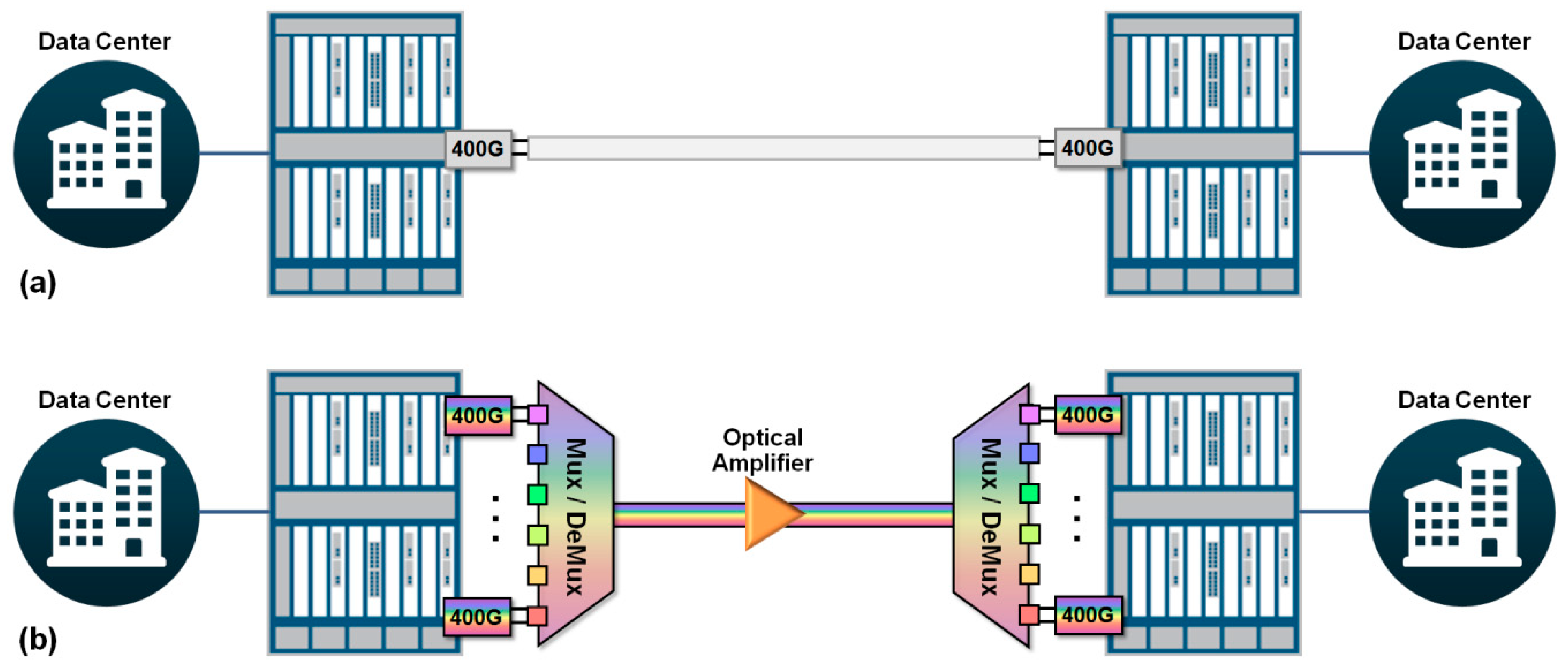
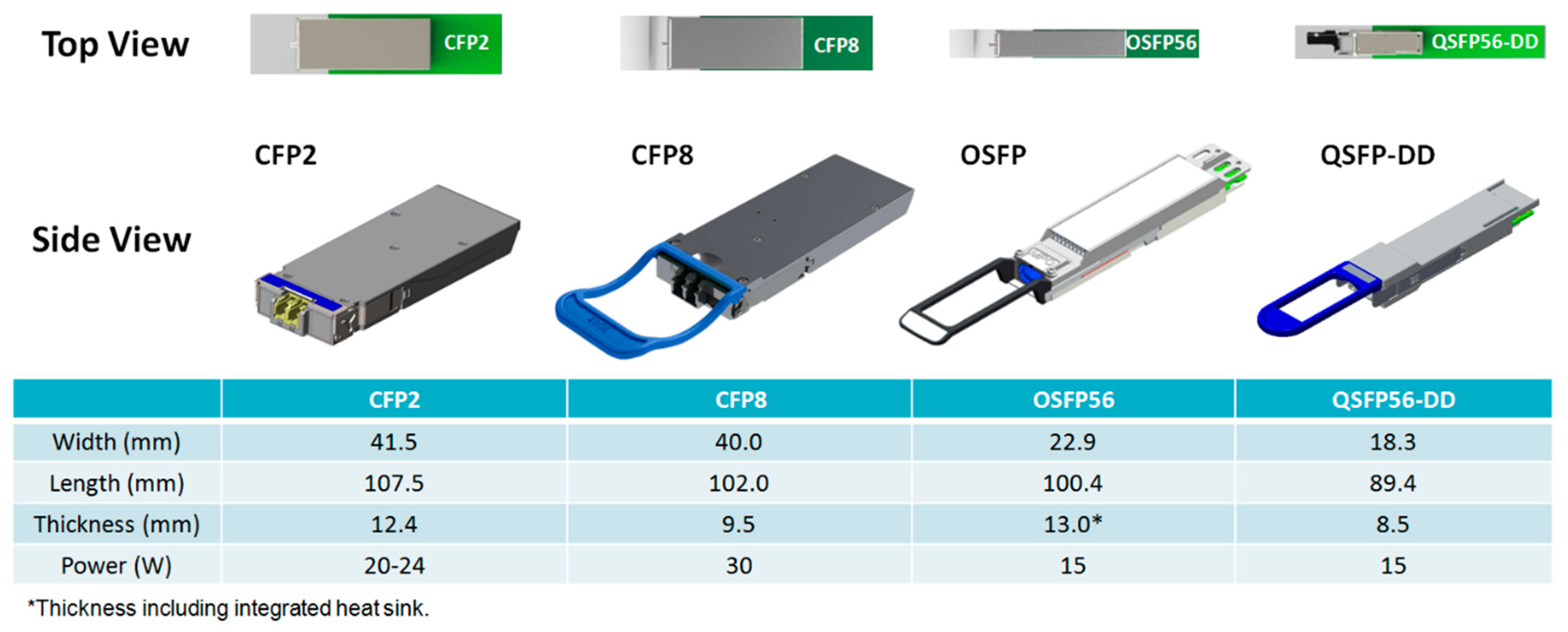


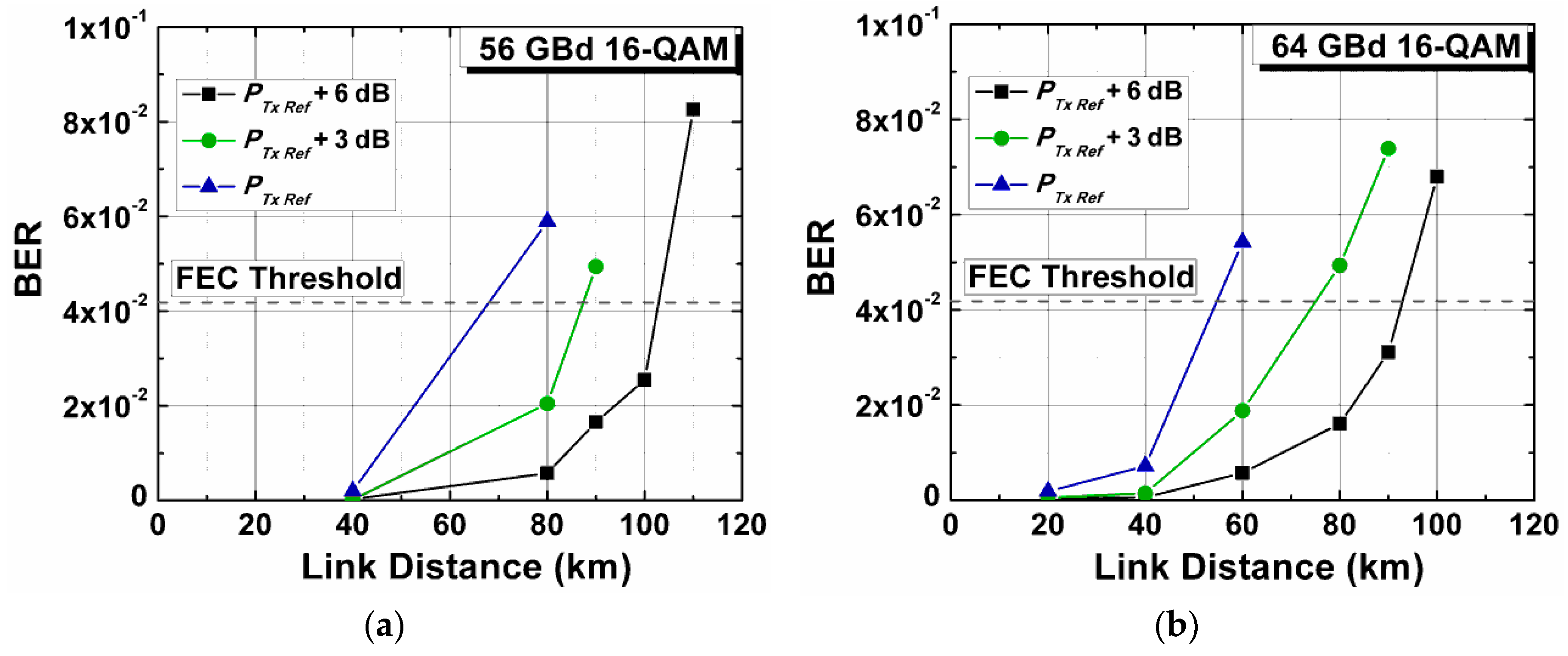
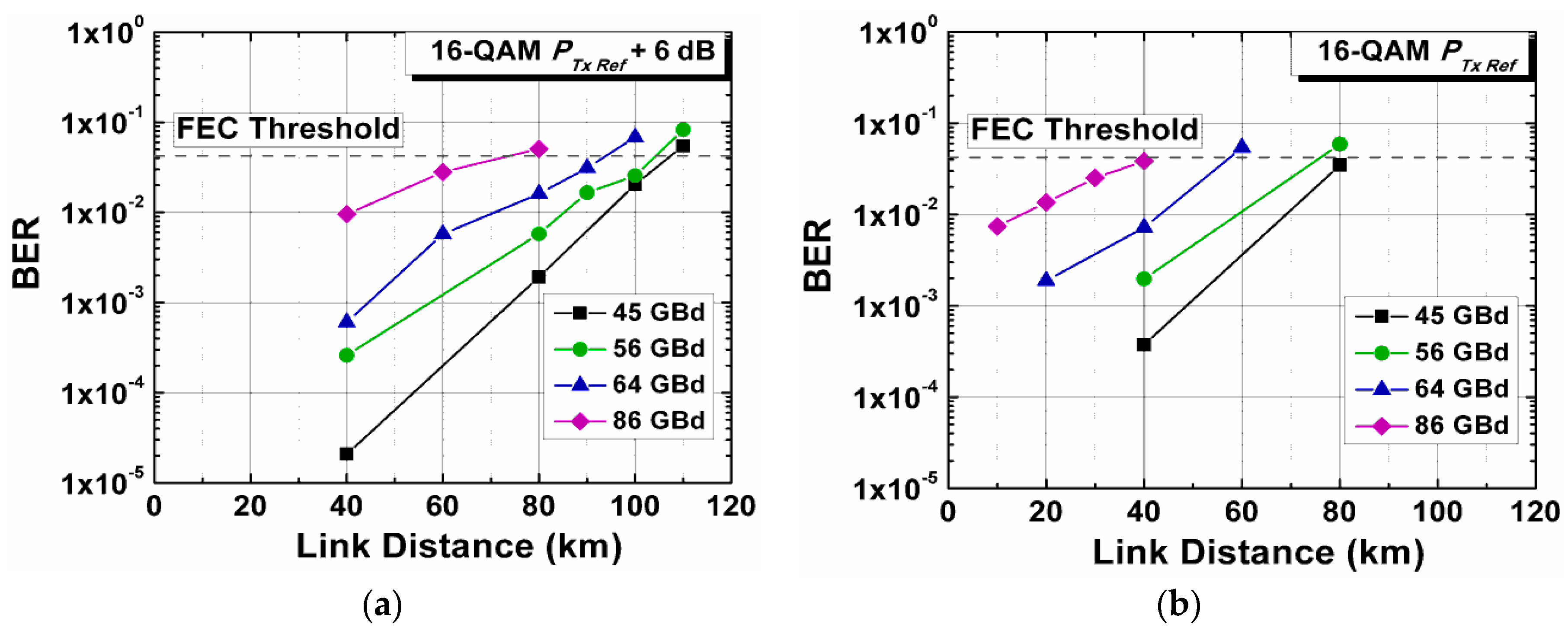
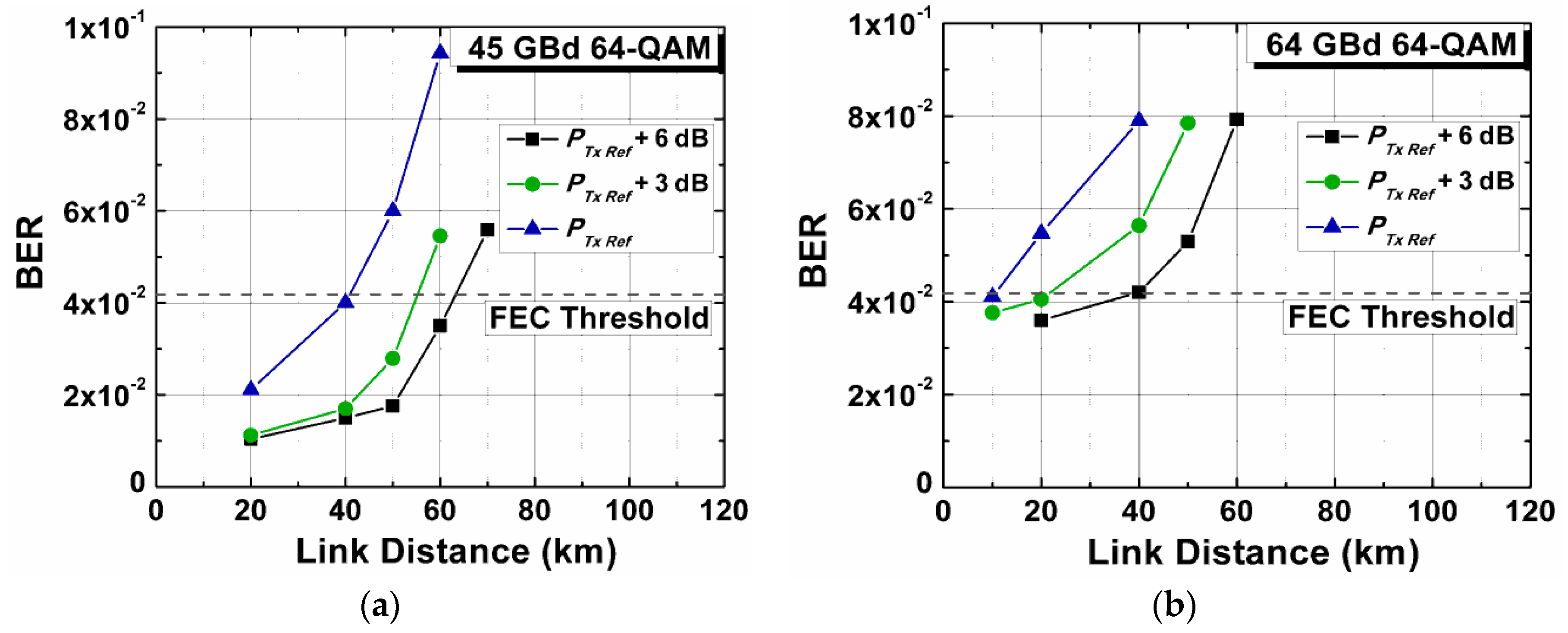
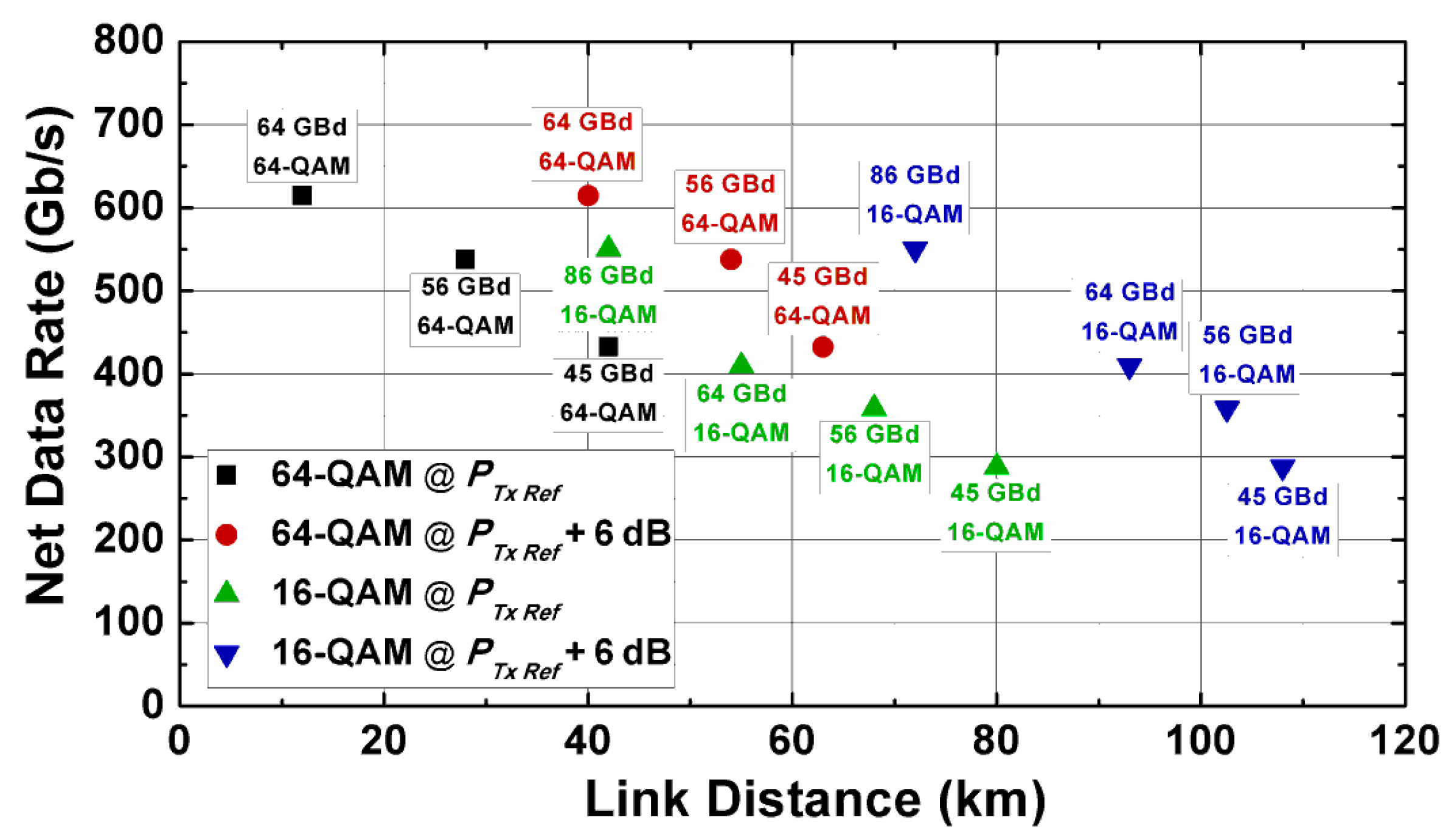
| DSP | 2012 | 2015 | 2017 | 2019 |
|---|---|---|---|---|
| CMOS node | 40 nm | 28 nm | 16 nm | 7 nm |
| Power/100G | <50 W | <20 W | <7 W | <2 W |
| Module Power | DSP | TROSA | Other |
|---|---|---|---|
| QSFP-DD | 7 W | 6–7 W | 1–2 W |
| Length (km) | 20 | 40 | 60 | 80 | 90 | 100 | 110 |
| Loss (dB) | 4.7 | 7.8 | 12.6 | 15.5 | 17.6 | 20.0 | 22.8 |
© 2019 by the authors. Licensee MDPI, Basel, Switzerland. This article is an open access article distributed under the terms and conditions of the Creative Commons Attribution (CC BY) license (http://creativecommons.org/licenses/by/4.0/).
Share and Cite
Yue, Y.; Wang, Q.; Anderson, J. Experimental Investigation of 400 Gb/s Data Center Interconnect Using Unamplified High-Baud-Rate and High-Order QAM Single-Carrier Signal. Appl. Sci. 2019, 9, 2455. https://doi.org/10.3390/app9122455
Yue Y, Wang Q, Anderson J. Experimental Investigation of 400 Gb/s Data Center Interconnect Using Unamplified High-Baud-Rate and High-Order QAM Single-Carrier Signal. Applied Sciences. 2019; 9(12):2455. https://doi.org/10.3390/app9122455
Chicago/Turabian StyleYue, Yang, Qiang Wang, and Jon Anderson. 2019. "Experimental Investigation of 400 Gb/s Data Center Interconnect Using Unamplified High-Baud-Rate and High-Order QAM Single-Carrier Signal" Applied Sciences 9, no. 12: 2455. https://doi.org/10.3390/app9122455
APA StyleYue, Y., Wang, Q., & Anderson, J. (2019). Experimental Investigation of 400 Gb/s Data Center Interconnect Using Unamplified High-Baud-Rate and High-Order QAM Single-Carrier Signal. Applied Sciences, 9(12), 2455. https://doi.org/10.3390/app9122455






